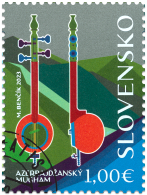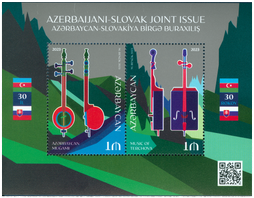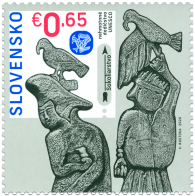802 Date of issue
02.10.2023 Face value
1.00 € Sell price
1.00 €
The first frets of Mugham – one of the main genres of Azerbaijani folk music – sounded in ancient times. Its performance art goes back to the tradition of Koran recitation or even earlier – to Sasanian Avesta hymns.
The meaning of the word “Mugham” is interpreted as “God sent music”. For the Azerbaijani people – it is not only a beautiful lyrical melody, but also a state of mind, a way to merge with the world and a kind of cosmic philosophy. Mugham is normally performed by three musicians – player on “tar”, player on “kamancha” which is bass instrument depicted on postage stamp and a singer “khanande”, who leads the main theme decorating it with improvisations and emotional shades.
Mugham as a genre took shape in Azerbaijan in the period of the “Muslim Renaissance”, which is attributed to the 12th –13th centuries when many great poets created. Their ghazals, like the poetry of later writers, formed the basis of Mugham. In those distant years, the formation of various schools of Mugham singers began in Baku, Shamakhi, Ganja, Nakhchivan, and, of course, in Karabakh. It was Shusha – “Conservatory of the East” – that gave the world the most outstanding singers. Their hallmark was the famous Mugham “Karabakh shikestesi”.
In 1908, the founder of the Azerbaijani composer school, Uzeyir Hajibayli, wrote the Mugham opera “Leyli and Majnun”. And in 1921, the Azerbaijan State Conservatory, in which the teaching of Mugham was included in the curriculum, was founded in Baku. In 2003, UNESCO proclaimed Azerbaijani Mugham a “Masterpiece of the Oral and Intangible Heritage of Humanity”. It was added to the UNESCO Intangible Cultural Heritage Lists in 2008.
Show less© 2024 POFIS - Postal philatelic service. All rights reserved



























